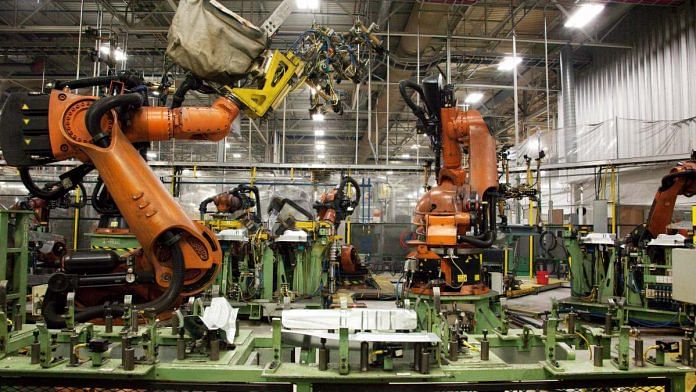New Delhi: The Indian economy grew at a record rate of 20.1 per cent in the first quarter of the current fiscal year but still lagged the output levels seen in the pre-Covid-19 era, data released by the National Statistical Office (NSO) Tuesday showed.
The economy had contracted by a record 24.4 per cent in the first quarter of 2020-21 as the first wave of the pandemic saw the government announcing a nationwide lockdown that brought most economic activity to a halt.
Data from NSO showed that GDP in constant prices was at Rs 32.4 lakh crore in Q1 2021-22, as against Rs 26.9 lakh crore in Q1 2020-21 and Rs 35.7 lakh crore in Q1 2019-20. The first quarter this year coincided with a devastating second wave of the pandemic while the first quarter of the last fiscal coincided with the first wave.
Economists point out that data suggests that the economic impact of the first wave of the pandemic was much more severe as compared to the second wave though India still has a long way to achieve its pre-pandemic output levels.
NSO data shows that while agriculture grew by 4.5 per cent, manufacturing grew by 50 per cent, construction grew by 68 per cent, and trade, hotels and restaurants grew by 34.3 per cent over the corresponding period last year. However, except for agriculture and electricity, gas and water supply, none of the other sectors saw their output surpassing levels seen in the first quarter of 2019-20.
NSO data also shows that private final consumption expenditure and gross fixed capital formation grew at 19 per cent and 55 per cent respectively as compared to the year-ago period but was substantially below the levels seen in Q1 of 2019-20. Government final consumption expenditure, however, contracted 5 per cent compared to last year.
Chief Economic Adviser Krishnamurthy Subramanian said the GDP data shows that the economy is on the path to recovery.
While the health impact of the second wave was significant, the impact on the economy has not been severe, he said in a press briefing after the GDP announcement, pointing out that a V-shaped recovery is underway.
India is poised for stronger growth due to the structural reforms that have been announced, he said, adding that full-year GDP growth is likely to be around 11 per cent.
Also read: India sees fastest growth this year among world’s major economies. This is what’s driving it
What economists say
Economists Sunil Kumar Sinha and Paras Jasrai of India Ratings and Research pointed out that despite the second wave of Covid, the economic activities remained alive as the local/regional restrictions imposed were not as stringent as they were during the first wave.
“However, to put things into perspective, the level of GDP in the first quarter of 2021-22 is still 9.2% lower than the level attained in the first quarter of 2019-20. This indicates that some of the grounds that the Indian economy had recovered by clocking a positive quarterly GDP growth of 0.5% in 3QFY21 and 1.6% in 4QFY21 got lost due to the COVID 2.0,” they said in a note.
Aditi Nayar, Chief Economist at ICRA Ltd, said the low base of last year’s stringent nationwide lockdown concealed the impact of the second wave of Covid.
“However, the sharp YoY expansion in Q1 FY2022 is analytically misleading, with a sequential slowdown of 16.9% over Q4 FY2021 and a shortfall of 9.2% relative to the pre-Covid level of Q1 FY2020,” she said.
“Manufacturing and construction were the key drivers of the pickup in GVA growth in Q1 FY2022, whereas on the expenditure side, private consumption and investment powered the YoY turnaround in the GDP performance. Nevertheless, all of these sectors remained well below their pre-covid levels in Q1 FY2022. On a sobering note, only agriculture and electricity posted a higher GVA in real terms relative to their pre-covid performance,” Nayar added.
Also read: Not selling govt land, assets: FM Sitharaman on Rs 6 lakh crore asset monetisation pipeline






